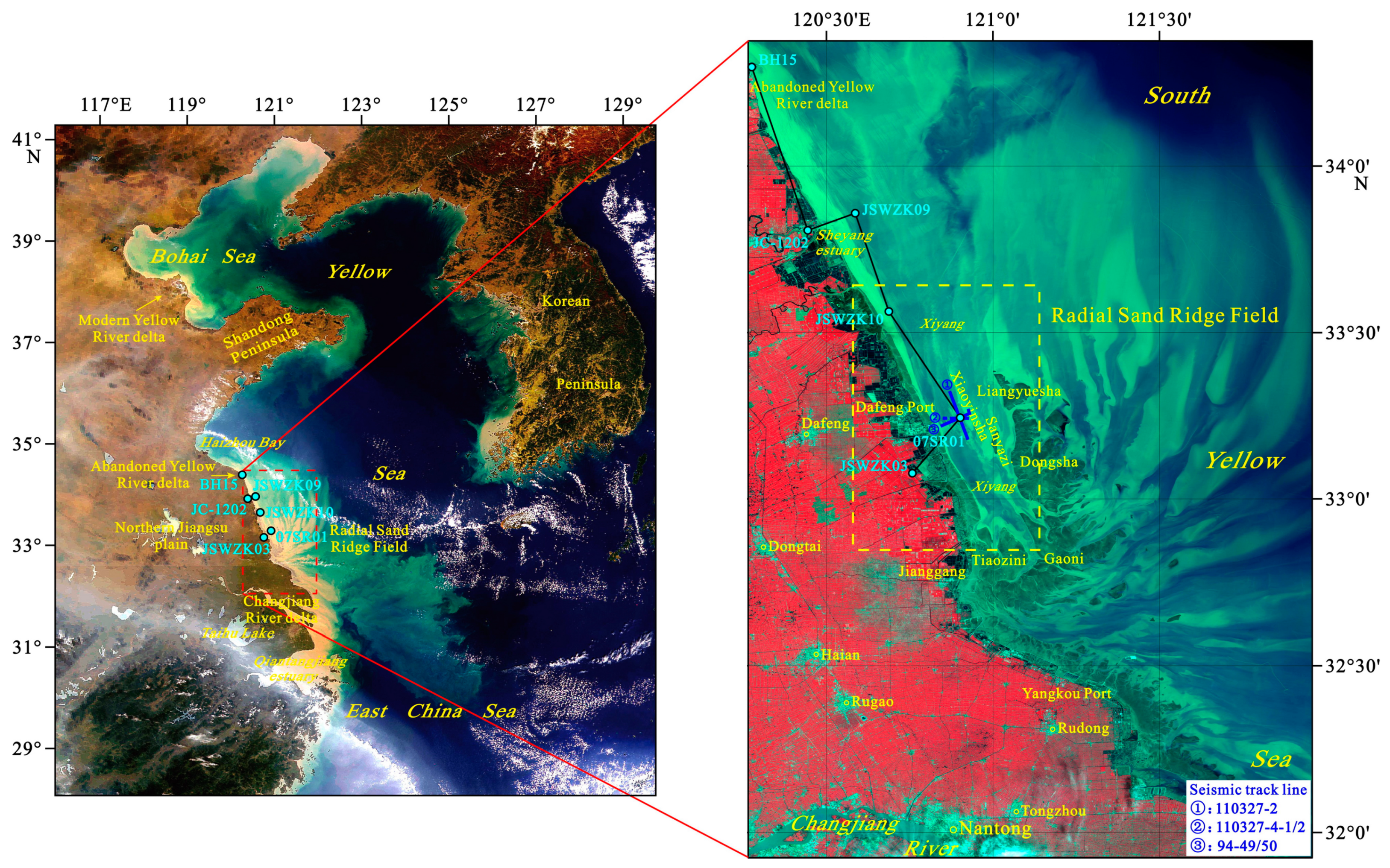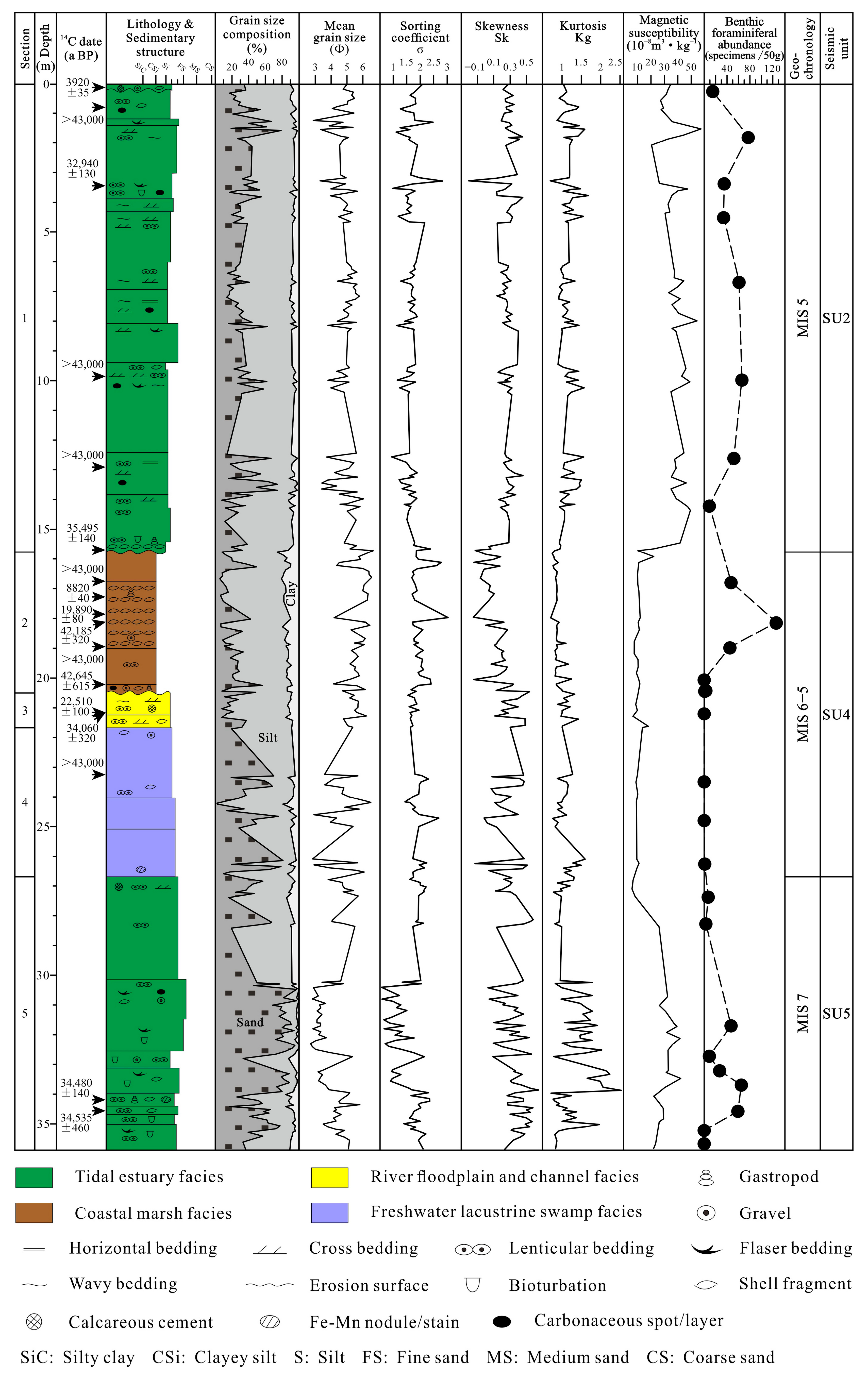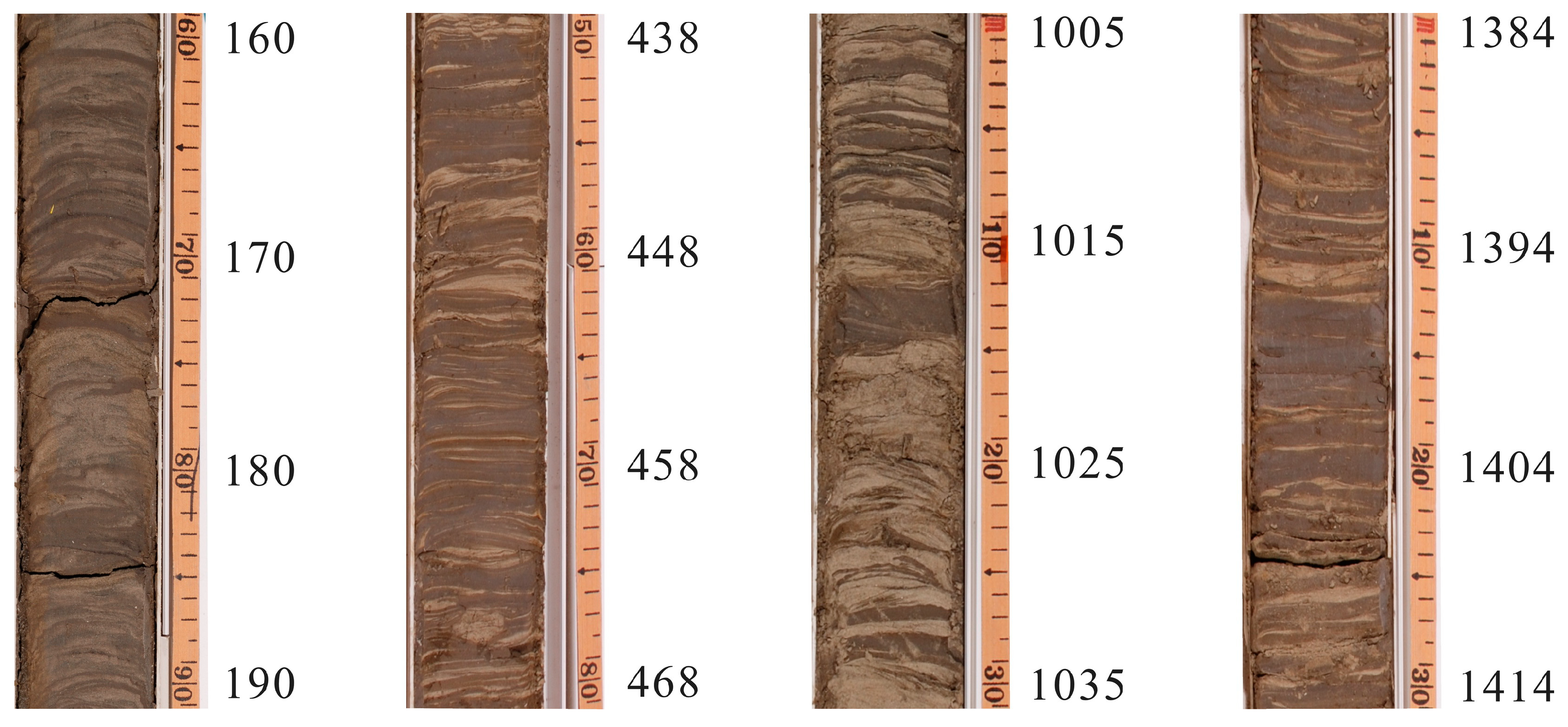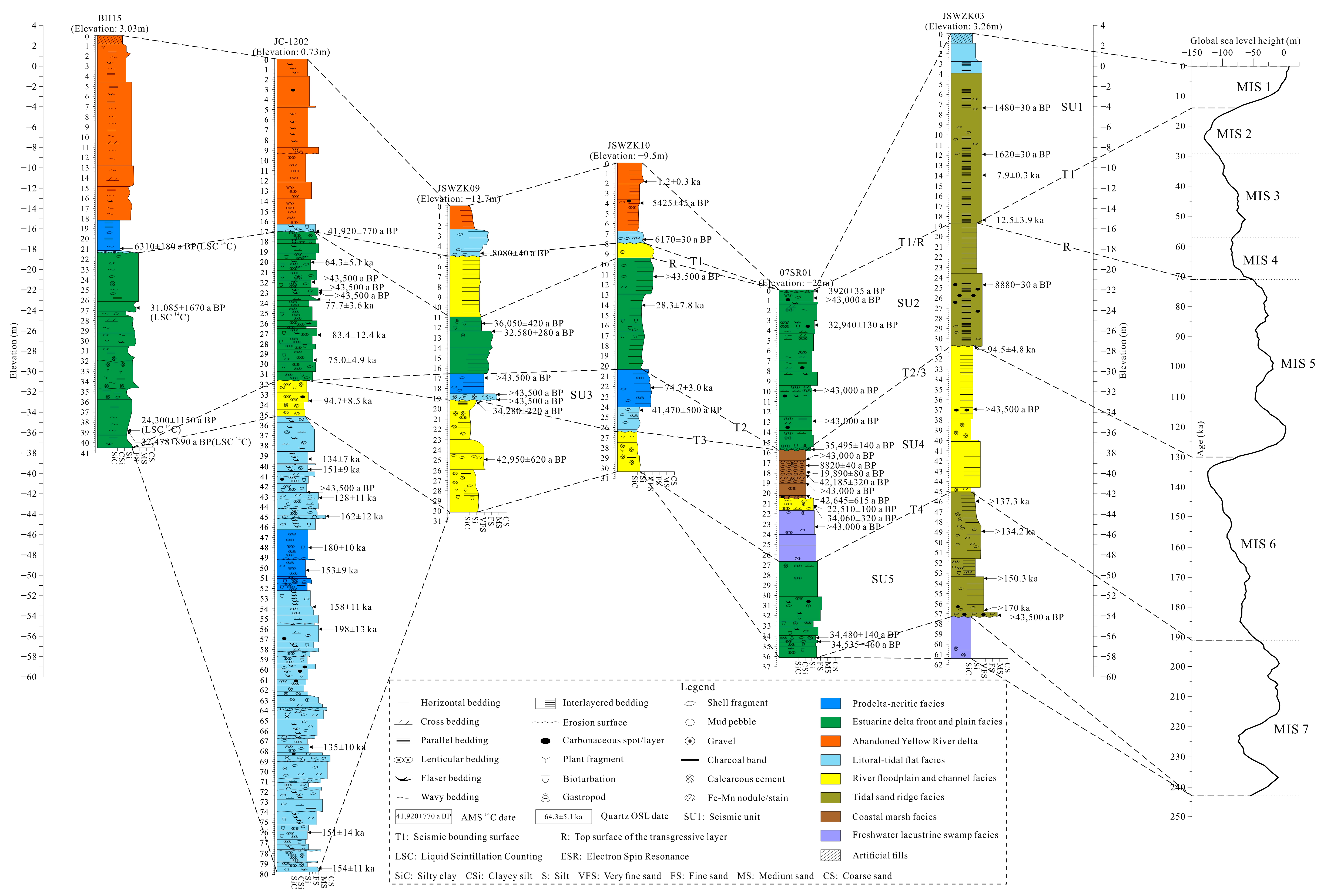Characteristics and Environmental Indications of Grain Size and Magnetic Susceptibility of the Late Quaternary Sediments from the Xiyang Tidal Channel, Western South Yellow Sea
Abstract
:1. Introduction
2. Regional Settings
3. Materials and Methods
3.1. Sample Collection
3.2. Laboratory Analysis
4. Results
4.1. General Characteristics and Correlations of Variations in Grain Size and Magnetic Susceptibility of Core 07SR01 Sediments
4.2. Characteristics and Correlations of Variations in Grain Size and Magnetic Susceptibility of Core 07SR01 Sediments in Different Sedimentary Facies
4.2.1. Tidal Estuarine Marginal Bank and Riverbed Facies (Section 5, 26.65–36.10 m)
4.2.2. Freshwater Lacustrine Swamp Facies (Section 4, 21.67–26.65 m)
4.2.3. River Floodplain Facies (Section 3, 20.50–21.67 m)
4.2.4. Coastal Marsh Facies (Section 2, 15.77–20.50 m)
4.2.5. Tidal Estuarine Delta Front Facies (Section 1, 0–15.77 m)
5. Discussion
5.1. Chronological Framework of Core 07SR01 Sediments
5.2. Environmental Indications for Combination of Grain Size and Magnetic Susceptibility of Core 07SR01 Sediments and Corresponding Regional Sedimentary Evolution
5.2.1. Stage 1 (MIS 7, Section 5: 36.10–26.65 m)
5.2.2. Stage 2 (MIS 6–5, Sections 4–2: 26.65–15.77 m)
5.2.3. Stage 3 (MIS 5, Section 1: 15.77–0 m)
6. Conclusions
Author Contributions
Funding
Institutional Review Board Statement
Informed Consent Statement
Data Availability Statement
Acknowledgments
Conflicts of Interest
References
- Prins, M.A.; Postma, G.; Weltje, G.J. Controls on terrigenous sediment supply to the Arabian Sea during the late Quaternary: The Makran continental slope. Mar. Geol. 2000, 169, 351–371. [Google Scholar] [CrossRef]
- Shu, Q.; Li, C.L.; Zhao, Z.J.; Chen, Y.; Zhang, M.H.; Li, J.J. The records of mass susceptibility and grain size for climate changes in Subei Basin during the last deglaciation. Acta Sediment. Sin. 2009, 27, 111–117, (In Chinese with English abstract). [Google Scholar]
- Cai, T.L.; Jia, J.J.; Wang, Y.P. Techniques for particle size data standardization: An example from estuarine and coastal sediments. Mar. Geol. Quat. Geol. 2014, 34, 185–193, (In Chinese with English abstract). [Google Scholar]
- Deng, C.W.; Zhang, X.; Lin, C.M.; Yu, J.; Wang, H.; Yin, Y. Grain-size characteristics and hydrodynamic conditions of the Changjiang estuarine deposits since last glacial. Mar. Geol. Quat. Geol. 2016, 36, 185–198, (In Chinese with English abstract). [Google Scholar]
- Wang, Z.B.; Yang, S.Y.; Zhang, Z.X.; Li, R.H.; Wang, H.; Lan, X.H. The grain size compositions of the surface sediments in the East China Sea: Indication for sedimentary environments. Oceanol. Limnol. Sin. 2012, 43, 1039–1049, (In Chinese with English abstract). [Google Scholar]
- Ding, D.L.; Zhang, X.H.; YU, J.J.; Wang, L.Y.; Wang, F.; Shang, S.W. Sediment grain size distribution patterns of the late Quaternary on the back side of northern Yangtze River Delta and their environmental implications. Mar. Geol. Quat. Geol. 2019, 39, 34–45, (In Chinese with English abstract). [Google Scholar]
- Zhou, L.C.; Li, J.; Gao, J.H.; Bai, F.L.; Zhao, J.T. Comparison of core sediment grain-size characteristics between Yangtze River estuary and Zhoushan Islands and its significance to sediment source analysis. Mar. Geol. Quat. Geol. 2009, 29, 21–27, (In Chinese with English abstract). [Google Scholar]
- Li, H.J.; Liu, Y.; Cheng, Y.; Zhang, C.P.; Gao, J.H.; Liu, J.W.; Zhang, L.; Zheng, J.H. Characteristics of sediment grain size at Yalu River estuary and implications for depositional environment. Mar. Geol. Quat. Geol. 2017, 37, 58–66, (In Chinese with English abstract). [Google Scholar]
- Pan, F.; Lin, C.M.; Li, Y.L.; Zhang, X.; Zhou, J.; Qu, C.W.; Yao, Y.L. Sediments grain-size characteristics and environmental evolution of Core SE2 in southern bank of Qiantang River since the Late Quaternary. J. Palaeogeogr. 2011, 13, 236–244, (In Chinese with English abstract). [Google Scholar]
- Thompson, R.; Oldfield, F. Environmental Magnetism; Allen & Unwin: London, UK, 1986; pp. 1–227. [Google Scholar]
- Verosub, K.L.; Roberts, A.P. Environmental magnetism: Past, present, and future. J. Geophys. Res. Solid Earth 1995, 100, 2175–2192. [Google Scholar] [CrossRef]
- Jia, H.L.; Liu, C.Z.; Zhang, W.G.; Meng, Y.; Hong, X.Q. Magnetic properties of core CY from Chongming island, the Yangtze estuary and its environmental significance. Acta Sediment. Sin. 2004, 22, 117–123, (In Chinese with English abstract). [Google Scholar]
- Zhang, R.H.; Xie, J.L.; Liu, T.; Zhao, B.C. Palaeoenvironmental evolution of subaqueous Yangtze delta inferred from sedimentary records. Mar. Geol. Quat. Geol. 2011, 31, 1–10, (In Chinese with English abstract). [Google Scholar] [CrossRef]
- Ge, Z.S. Study on magnetic susceptibility of hole QC2 in the South Yellow Sea. Mar. Geol. Quat. Geol. 1996, 16, 35–42, (In Chinese with English abstract). [Google Scholar]
- Yim, W.W.-S.; Huang, G.; Chan, L.S. Magnetic susceptibility study of Late Quaternary inner continental shelf sediments in the Hong Kong SAR, China. Quatern. Int. 2004, 117, 41–54. [Google Scholar] [CrossRef]
- Yao, J. Climatic Indicators and Sedimentary Environment Studies Inferred from Transgressive and Regressive Sediments of Core LZ908, South Bohai Sea. Ph.D. Thesis, The University of Chinese Academy of Sciences (Institute of Oceanology, Chinese Academy of Sciences), Qingdao, China, 2014; pp. 1–118, (In Chinese with English abstract). [Google Scholar]
- Maher, B.A. Magnetic properties of some synthetic sub-micron magnetites. Geophys. J. Int. 1988, 94, 83–96. [Google Scholar] [CrossRef]
- Wang, J.; Liu, Z.C.; Jiang, W.Y.; Dong, L.X.; Zhu, M.Z.; Gao, F. A relationship between susceptibility and grain-size and minerals, and their paleo-environmental implications. Acta Geogr. Sin. 1996, 51, 155–163, (In Chinese with English abstract). [Google Scholar]
- Zhou, X.; Sun, L.G.; Huang, W.; Liu, Y.; Jia, N.; Cheng, W.H. Relationship between magnetic susceptibility and grain size of sediments in the China Seas and its implications. Cont. Shelf Res. 2014, 72, 131–137. [Google Scholar] [CrossRef]
- Wang, L.S.; Hu, S.Y.; Yu, G.; Ma, M.M.; Liao, M.N. Paleoenvironmental reconstruction of the radial sand ridge field in the South Yellow Sea (east China) since 45 ka using the sediment magnetic properties and granulometry. J. Appl. Geophys. 2015, 122, 1–10. [Google Scholar] [CrossRef]
- Wei, L.H.; Jiang, H.C.; He, H.L.; Xu, Y.R.; Gao, W.; Wei, Z.Y. Heinrich-5 Event revealed by high-resolution grain-size and magnetic susceptibility records and its significance of climate evolution in the last glacial at Hongtong, Shanxi, China. Mar. Geol. Quat. Geol. 2018, 38, 193–202, (In Chinese with English abstract). [Google Scholar]
- Hilton, J. A simple model for the interpretation of magnetic records in lacustrine and ocean sediments. Quaternary Res. 1987, 27, 160–166. [Google Scholar] [CrossRef]
- Liu, J.; Zhu, R.X.; Li, S.Q. Magnetic properties of the last glacial brown-yellow fine-grained sediment in the northern South Yellow Sea: Implication for its origin. Mar. Geol. Quat. Geol. 2002, 22, 15–20, (In Chinese with English abstract). [Google Scholar]
- Liu, J.; Zhu, R.X.; Li, S.Q.; Chang, J.H. Magnetic mineral diagenesis in the post-glacial muddy sediments from the southeastern South Yellow Sea: Response to marine environmental changes. Sci. China Ser. D 2005, 48, 134–144. [Google Scholar] [CrossRef]
- Liu, G.; Han, X.B.; Chen, Y.P.; Hu, B.Q.; Yi, L. Magnetic characteristics of core YSC-10 sediments in the central Yellow Sea mud area and implications for provenance changes. Acta Sediment. Sin. 2021, 39, 383–394, (In Chinese with English abstract). [Google Scholar]
- Wang, Y. Radiative Sandy Ridge Field on Continental Shelf of the Yellow Sea; China Environmental Science Press: Beijing, China, 2002; pp. 1–373. (In Chinese) [Google Scholar]
- Wang, Y. Environment and Resource of the Radial Sand Ridge Field in the South Yellow Sea; China Ocean Press: Beijing, China, 2014; pp. 1–293. (In Chinese) [Google Scholar]
- Xia, F.; Yin, Y.; Wang, Q.; Zhang, Y.Z.; Liu, J.P. Sequence stratigraphy of the central part of North Jiangsu coasts since late MIS 3, eastern China. Acta Geol. Sin. 2012, 86, 1696–1712, (In Chinese with English abstract). [Google Scholar]
- Xia, F.; Zhang, Y.Z.; Wang, Q.; Yin, Y.; Wegmann, K.W.; Liu, J.P. Evolution of sedimentary environments of the middle Jiangsu coast, South Yellow Sea since late MIS 3. J. Geogr. Sci. 2013, 23, 883–914. [Google Scholar] [CrossRef]
- Zhang, G.; Yang, L.K.; Yan, Y.R.; Fan, Y.B.; Zhao, G. Variation characteristics of siltation movement at the Xiyang deep groove of Dafeng port in Yancheng, Jiangsu province. J. Geol. 2016, 40, 683–689, (In Chinese with English abstract). [Google Scholar]
- The Office of 908 Special Project of the State Oceanic Administration of China. Technical Regulations for Marine Bottom Sediment Investigation; China Ocean Press: Beijing, China, 2006; pp. 1–63. (In Chinese) [Google Scholar]
- Blott, S.J.; Pye, K. GRADISTAT: A grain size distribution and statistics package for the analysis of unconsolidated sediments. Earth Surf. Proc. Land. 2001, 26, 1237–1248. [Google Scholar] [CrossRef]
- Xia, F. Shallow Sequence Stratigraphy and Sedimentary Evolution of the Xiyang Tidal Channel in the Radial Sand Ridge Field. Ph.D. Thesis, Nanjing University, Nanjing, China, 2016; pp. 1–187, (In Chinese with English abstract). [Google Scholar]
- Xia, F.; Zhang, Y.Z.; Liu, D.Z. Rethinking on shallow sedimentary sequence and its evolution of the Xiyang tidal channel in the Radial Sand Ridge Field, South Yellow Sea. Mar. Geol. Quat. Geol. 2021, 41, 13–26, (In Chinese with English abstract). [Google Scholar]
- Reineck, H.-E.; Singh, I.B. Depositional Sedimentary Environments: With Reference to Terrigenous Clastics, 2nd ed.; Springer: Berlin/Heidelberg, Germany, 1980; pp. 321–338. [Google Scholar]
- Hori, K.; Saito, Y.; Zhao, Q.H.; Wang, P.X. Architecture and evolution of the tide-dominated Changjiang (Yangtze) River delta, China. Sediment. Geol. 2002, 146, 249–264. [Google Scholar] [CrossRef]
- Berné, S.; Vagner, P.; Guichard, F.; Lericolais, G.; Liu, Z.X.; Trentesaux, A.; Yin, P.; Yi, H.I. Pleistocene forced regressions and tidal sand ridges in the East China Sea. Mar. Geol. 2002, 188, 293–315. [Google Scholar] [CrossRef]
- Davis, R.A., Jr.; Dalrymple, R.W. Principles of Tidal Sedimentology; Springer: New York, NY, USA, 2012; pp. 79–149. [Google Scholar]
- Meng, Q.Y.; Li, A.C.; Xu, F.J.; Zhou, X.J.; Li, C.S. Correlation between the grain size distribution and magnetic susceptibility of marine sediment core in the inner shelf of the East China Sea. Sci. Tech. Rev. 2009, 27, 32–36, (In Chinese with English abstract). [Google Scholar]
- Yim, W.W.-S.; Ivanovich, M.; Yu, K.F. Young age bias of radiocarbon dates in pre-Holocene marine deposits of Hong Kong and implications for Pleistocene stratigraphy. Geo-Mar. Lett. 1990, 10, 165–172. [Google Scholar] [CrossRef]
- Pigati, J.S.; Quade, J.; Wilson, J.; Timothy Jull, A.J.; Lifton, N.A. Development of low-background vacuum extraction and graphitization systems for 14C dating of old (40–60 ka) samples. Quatern. Int. 2007, 166, 4–14. [Google Scholar] [CrossRef]
- Yi, L.; Jiang, X.Y.; Tian, L.Z.; Yu, H.J.; Xu, X.Y.; Shi, X.F.; Qin, H.F.; Deng, C.L. Geochronological study on Plio-Pleistocene evolution of Bohai Basin. Quat. Sci. 2016, 36, 1075–1087, (In Chinese with English abstract). [Google Scholar]
- Long, H.; Zhang, J.R. Luminescence dating of Late Quaternary lake-levels in northern China. Quat. Sci. 2016, 36, 1191–1203, (In Chinese with English abstract). [Google Scholar]
- Long, Z.R.; Wang, Z.B.; Tu, H.; Li, R.H.; Wen, Z.H.; Wang, Y.X.; Zhang, Y.; Lai, Z.P. OSL and radiocarbon dating of a core from the Bohai Sea in China and implication for Late Quaternary transgression pattern. Quat. Geochronol. 2022, 70, 101308. [Google Scholar] [CrossRef]
- Gao, L.; Long, H. Luminescence chronology constraints on the sedimentary stratigraphy of the Yangtze River delta since MIS 5. Quat. Sci. 2023, 43, 33–45, (In Chinese with English abstract). [Google Scholar]
- Wang, J.; Zhou, C.L.; Xu, X.B. Research Report for the characteristics and sedimentary environments of the shallow strata of the 10,000-ton wharf at Zhongshan Port, Binhai County, Jiangsu Province; Nanjing Normal University: Nanjing, China, 1995; pp. 1–20. (In Chinese) [Google Scholar]
- Zhang, X. Chronology and Sedimentary Environment Change in the Coastal-Shelf Areas of Eastern China Since 200 ka. Ph.D. Thesis, China University of Geosciences, Wuhan, China, 2021; pp. 1–122, (In Chinese with English abstract). [Google Scholar]
- He, L.; Ye, S.Y.; Xue, C.T.; Zhao, G.M.; Yang, S.X.; Amorosi, A. Sedimentology and evolution of the Holocene radial tidal sand ridge in the south Yellow Sea, China. Front. Earth Sci. 2023, 10, 1107495. [Google Scholar] [CrossRef]
- Spratt, R.M.; Lisiecki, L.E. A Late Pleistocene sea level stack. Clim. Past. 2016, 12, 1079–1092. [Google Scholar] [CrossRef]
- Liu, Q.S.; Deng, C.L. Magnetic susceptibility and its environmental significances. Chin. J. Geophys. 2009, 52, 1041–1048, (In Chinese with English abstract). [Google Scholar]
- Murray-Wallace, C.V.; Woodroffe, C.D. Quaternary Sea-Level Changes: A Global Perspective; Cambridge University Press: New York, NY, USA, 2014; pp. 256–368. [Google Scholar]
- Ke, X.K. Grain-size characteristics of tidal flat sediments. Mar. Sci. Bull. 1988, 7, 41–48. (In Chinese) [Google Scholar]
- Chen, Y.Y.; Xia, F.; Zhang, Z.K.; Xu, Q.M.; Chen, S.Y. Research progress on distribution of Quaternary buried paleo-Yangtze River channels in the North Jiangsu-western South Yellow Sea. Mar. Geol. Quat. Geol. 2020, 40, 40–54, (In Chinese with English abstract). [Google Scholar]
- Li, P.; Chen, G. Early diagenesis of Late Pleistocene dark-green stiff clay in the Yangzi River delta. Oil Gas Geol. 1995, 16, 313–318+401, (In Chinese with English abstract). [Google Scholar]
- Xia, F.; Zhang, Y.Z.; Wang, L.; Liu, D.Z. Sedimentary sequence and age of core NTCJ1 in the Sheyang estuary, western South Yellow Sea: A re-interpretation. Water 2023, 15, 3617. [Google Scholar] [CrossRef]







| Depth (m) | Mean Grain Size (Φ) | Sorting Coefficient | Skewness | Kurtosis | Sample Quantity | |
|---|---|---|---|---|---|---|
| 0–36.10 (Whole core) | Minimum | 2.70 | 0.55 | −0.20 | 0.69 | 229 |
| Maximum | 6.66 | 3.03 | 0.64 | 2.52 | ||
| Mean | 4.76 | 1.71 | 0.26 | 1.14 | ||
| 26.65–36.10 (Tidal estuarine marginal bank and riverbed facies) | Minimum | 2.70 | 0.55 | 0.02 | 0.71 | 65 |
| Maximum | 5.81 | 2.35 | 0.64 | 2.53 | ||
| Mean | 4.02 | 1.56 | 0.35 | 1.32 | ||
| 21.67–26.65 (Freshwater lacustrine swamp facies) | Minimum | 2.83 | 1.51 | −0.12 | 0.75 | 22 |
| Maximum | 6.50 | 2.69 | 0.50 | 1.59 | ||
| Mean | 4.66 | 1.95 | 0.23 | 1.08 | ||
| 20.50–21.67 (River floodplain facies) | Minimum | 4.78 | 1.54 | 0.11 | 0.88 | 11 |
| Maximum | 6.24 | 1.94 | 0.48 | 1.42 | ||
| Mean | 5.48 | 1.71 | 0.32 | 1.09 | ||
| 15.77–20.50 (Coastal marsh facies) | Minimum | 4.14 | 1.65 | −0.15 | 0.70 | 36 |
| Maximum | 6.55 | 3.03 | 0.53 | 1.24 | ||
| Mean | 5.66 | 1.98 | 0.12 | 0.87 | ||
| 0–15.77 (Tidal estuarine delta front facies) | Minimum | 2.88 | 0.94 | −0.20 | 0.69 | 95 |
| Maximum | 6.66 | 2.82 | 0.45 | 1.68 | ||
| Mean | 4.86 | 1.65 | 0.25 | 1.14 |
| Core Section (Depth or Sedimentary Facies) | Grain Size (Φ) | ||||
|---|---|---|---|---|---|
| >8 | 6–8 | 5–6 | 4–5 | <4 | |
| 0–36.10 m | −0.544 ** | −0.407 ** | −0.207 * | 0.126 | 0.280 ** |
| 26.65–36.10 m | −0.600 ** | −0.514 ** | −0.633 ** | −0.817 ** | 0.712 ** |
| 15.77–26.65 m | 0.018 | −0.024 | −0.025 | 0.145 * | −0.030 |
| 0–15.77 m | −0.500 ** | −0.304 * | −0.087 | 0.118 | 0.254 * |
| Tidal estuarine marginal bank and riverbed facies | −0.600 ** | −0.514 ** | −0.633 ** | −0.817 ** | 0.712 ** |
| Freshwater lacustrine swamp facies | 0.084 | 0.141 * | 0.187 * | 0.164 * | −0.163 * |
| River floodplain facies | −0.935 ** | −0.690 ** | −0.028 | 0.620 ** | 0.581 ** |
| Coastal marsh facies | −0.058 | −0.112 * | −0.177 * | 0.066 | 0.109 |
| Tidal estuarine delta front facies | −0.500 ** | −0.304 * | −0.087 | 0.118 | 0.254 * |
Disclaimer/Publisher’s Note: The statements, opinions and data contained in all publications are solely those of the individual author(s) and contributor(s) and not of MDPI and/or the editor(s). MDPI and/or the editor(s) disclaim responsibility for any injury to people or property resulting from any ideas, methods, instructions or products referred to in the content. |
© 2024 by the authors. Licensee MDPI, Basel, Switzerland. This article is an open access article distributed under the terms and conditions of the Creative Commons Attribution (CC BY) license (https://creativecommons.org/licenses/by/4.0/).
Share and Cite
Xia, F.; Liu, D.; Zhang, Y. Characteristics and Environmental Indications of Grain Size and Magnetic Susceptibility of the Late Quaternary Sediments from the Xiyang Tidal Channel, Western South Yellow Sea. J. Mar. Sci. Eng. 2024, 12, 699. https://doi.org/10.3390/jmse12050699
Xia F, Liu D, Zhang Y. Characteristics and Environmental Indications of Grain Size and Magnetic Susceptibility of the Late Quaternary Sediments from the Xiyang Tidal Channel, Western South Yellow Sea. Journal of Marine Science and Engineering. 2024; 12(5):699. https://doi.org/10.3390/jmse12050699
Chicago/Turabian StyleXia, Fei, Dezheng Liu, and Yongzhan Zhang. 2024. "Characteristics and Environmental Indications of Grain Size and Magnetic Susceptibility of the Late Quaternary Sediments from the Xiyang Tidal Channel, Western South Yellow Sea" Journal of Marine Science and Engineering 12, no. 5: 699. https://doi.org/10.3390/jmse12050699






